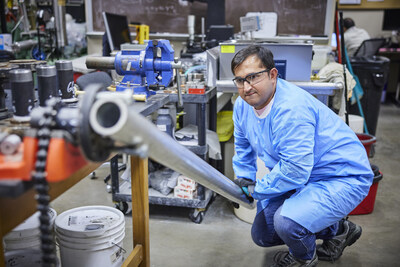University of Oklahoma to Lead Oklahoma Carbon Hub
The $18.7M project, funded by the U.S. Department of Energy, will research potential carbon storage sites.
NORMAN, Okla., Nov. 25, 2024 /PRNewswire/ -- A team of researchers from across the University of Oklahoma Mewbourne College of Earth and Energy, Los Alamos National Laboratory, with industry partners, have been awarded an $18.7M grant from the U.S. Department of Energy to investigate commercial subsurface storage of carbon dioxide (CO2). The project, the Oklahoma Carbon Hub, will investigate three separate sites in Osage and Kay Counties as potential locations for the injection of approximately 54 million metric tonnes of carbon dioxide over 20 years. For reference, the average car in the U.S. will produce one metric ton of CO2 over a three-month period.
"We're emitting more and more carbon dioxide into the atmosphere over time. If we could capture that carbon dioxide at certain point sources, we could use these types of facilities to store it long-term. With this grant and the Mewbourne College of Earth and Energy's history of expertise in the subsurface, OU will be able to directly impact and participate in reducing CO2 emissions into our atmosphere," said Matthew Pranter, Ph.D., director of the OU School of Geosciences and Eberly Family Chair, the lead principal investigator on the grant. "We're trying to help with the global issue of climate change and mitigate or reduce the amount of CO2 that's going into the atmosphere."
There are already three committed customers (sources of CO2) if the storage solutions are deemed feasible. The CVR Fertilizer Plant near Coffeyville, KS, the Azure Sustainable Aviation Fuel Production Facility near Cherryvale, KS, and the Heimdal Direct Air Capture Units on the Osage Reservation in Oklahoma will store CO2 emissions through the Hub.
Subsurface geological storage is one option for storing CO2 after it has been captured or removed from the atmosphere. Pranter says this is a potentially favorable option because oil and natural gas that are deep under the surface have been trapped there for millions of years and have not migrated to the surface.
For these potential sites, it is important to characterize and quantify the spatial distribution of pore space and minerals in the subsurface and determine the optimal locations to drill injection wells. A vital part of this process will be drilling wells to acquire cores several hundreds of feet thick, giving researchers direct observation of the rock itself. The target rock layer is the Arbuckle Group, a primarily limestone and dolomite formation.
Pranter says that the Arbuckle Group in the study area has high porosity, and the rock formations above have low porosity and permeability and would act as a seal to keep the stored CO2 in the Arbuckle Group. "We know that the rock formations are such that they do act as natural storage tanks in the subsurface," he said.
According to Pranter, certain types of rocks chemically react with CO2, transforming the CO2 over time into a mineral. While this is not necessarily the case in The Oklahoma Carbon Hub sites, it is possible.
The Hub is part of the U.S. Department of Energy's Carbon Storage Assurance Facility Enterprise (CarbonSAFE) initiative and a $518M effort by the DOE's Office of Fossil Energy and Carbon Management to fund a third round of projects focused on carbon storage site characterization and permitting. The Oklahoma Carbon Hub will become the first CarbonSAFE program awarded by DOE in the state of Oklahoma.
"This project involves detailed subsurface characterization up to the point where we can move forward with preparing and submitting applications to permit wells that could be used to inject CO2 over the long term for permanent subsurface storage," said Pranter.
Read more at ou.edu/news
About the University of Oklahoma
Founded in 1890, the University of Oklahoma is a public research university located in Norman, Oklahoma. As the state's flagship university, OU serves the educational, cultural, economic and health care needs of the state, region and nation. For more information about the university, visit www.ou.edu.
Photos available via Dropbox
![]() View original content to download multimedia:https://www.prnewswire.com/news-releases/university-of-oklahoma-to-lead-oklahoma-carbon-hub-302315628.html
View original content to download multimedia:https://www.prnewswire.com/news-releases/university-of-oklahoma-to-lead-oklahoma-carbon-hub-302315628.html
SOURCE University of Oklahoma


